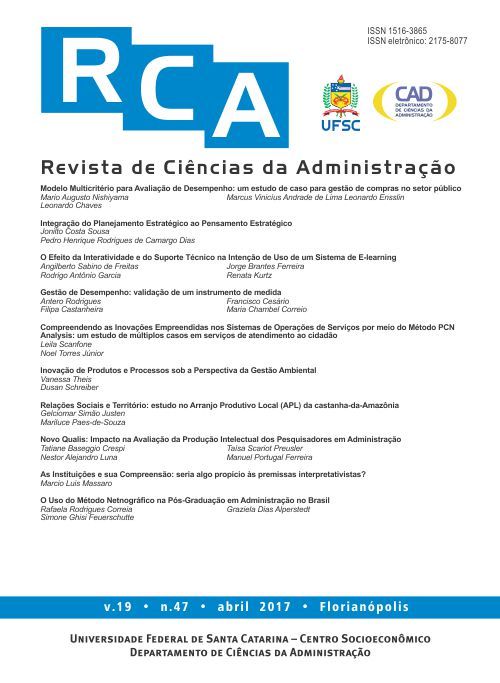Performance Management: Validation of a Measuring Instrument
DOI:
https://doi.org/10.5007/2175-8077.2017v19n47p57Abstract
The present research aims to validate and adapt a performance management measure in Portugal. In this study participated 1815. Stable and adequate psychometric properties were obtained (factorial validity, internal consistency and convergent validity). The measure consists of 28 items, divided into 5 factors (supervisor-employee relationship, favorable feedback, unfavorable feedback, document, and results), and coded on a 5-point Likert scale, which differs from the structure found by the originals authors. Furthermore, the relationship between this measure and the reaction to feedback was analyzed. We obtained a positive correlation between the sub-dimensions of this scale and the one regarding the reaction to feedback. In conclusion, this scale is a valuable asset as it allows a multidimensional perspective of performance management. In other words, it allows the analysis of the results following from the appraisal and the provision of valuable data regarding the communication of those results to the employees.Downloads
Published
How to Cite
Issue
Section
License
The author must ensure:
- that there is complete consensus among all co-authors to approve the final version of the paper and its submission for publication.
- that their work is original, and if the work and/or words of others have been used, these have been duly acknowledged.
Plagiarism in all its forms constitutes unethical publishing behavior and is unacceptable. RCA reserves the right to use software or any other methods of plagiarism detection.
All submissions received for evaluation in the RCA journal are screened for plagiarism and self-plagiarism. Plagiarism identified in manuscripts during the evaluation process will result in the submission being archived. In the event of plagiarism being identified in a manuscript published in the journal, the Editor-in-Chief will conduct a preliminary investigation and, if necessary, retract it.
Authors grant RCA exclusive rights of first publication, with the work simultaneously licensed under the Creative Commons (CC BY) 4.0 International License.

Authors are authorized to enter into separate, additional contractual arrangements for the non-exclusive distribution of the version of the work published in this journal (e.g., publishing in an institutional repository, on a personal website, publishing a translation, or as a chapter in a book), with an acknowledgement of its authorship and initial publication in this journal.
This license grants any user the right to:
Share – copy, download, print, or redistribute the material in any medium or format.
Adapt – remix, transform, and build upon the material for any purpose, even commercially.
According to the following terms:
Attribution – You must give appropriate credit (cite and reference), provide a link to the license, and indicate if changes were made. You may do so in any reasonable manner, but not in any way that suggests the licensor endorses you or your use.
No additional restrictions – You may not apply legal terms or technological measures that legally restrict others from doing anything the license permits.


